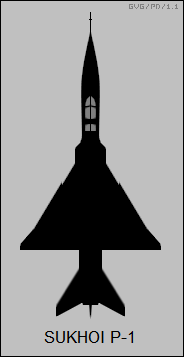Sukhoi P-1 on:
[Wikipedia]
[Google]
[Amazon]
The Sukhoi P-1 was a prototype

Soviet
The Soviet Union,. officially the Union of Soviet Socialist Republics. (USSR),. was a transcontinental country that spanned much of Eurasia from 1922 to 1991. A flagship communist state, it was nominally a federal union of fifteen nation ...
interceptor.
Development
Sukhoi began design studies for what was to become Izdeliye P in 1954 to meet an urgent request from the Ministry of Aviation Industry (MAP – ''Ministerstvo Aviatsionnoy Promyshlennosti'' – ministry of aviation industry). The early studies considered crew size, armament (missiles, cannon or both), and powerplant (with a choice of Lyul'ka AL-9 or AL-11, Klimov VK-9F, Kuznetsov P-2 or Kuznetsov P-4 engines). The P-1 was designed for the ''Uragan-1'' (Hurricane-1) collision-course interceptradar
Radar is a detection system that uses radio waves to determine the distance ('' ranging''), angle, and radial velocity of objects relative to the site. It can be used to detect aircraft, ships, spacecraft, guided missiles, motor vehicles, we ...
, which was quite complex and bulky, requiring a crew of two and air intakes either side of the fuselage rather than at the nose, retaining the delta wing of the Sukhoi T-3
The Sukhoi T-3 was a prototype Soviet fighter aircraft.
Development
Starting in the early 1950s, the development of the T-3 proceeded in parallel with the S-1 which would eventually become the Sukhoi Su-7. While the S-1 was a conventional swept ...
with 57-degree leading edge sweep. Although the production aircraft was intended to use the Lyul'ka AL-9 engine, then in development, the prototype was fitted with a Lyulka AL-7
The Lyulka AL-7 was a turbojet designed by Arkhip Mikhailovich Lyulka and produced by his Lyulka design bureau. The engine was produced between 1954 and 1970.Gunston 1989, p.100.
Design and development
The AL-7 had supersonic airflow through th ...
F of lower power.
The P-1 first flew in July 1957 but underwent only limited flight testing due to unavailability of the intended powerplant and ongoing problems with the radar and missile systems as well as lukewarm enthusiasm from the VVS (''Voyenno-Vozdooshnyye Seely'' – Soviet air forces). OKB-51 persisted for some time trying to raise enthusiasm for the P-1 by proposing an even bigger engine, the Tumansky R-15
The Tumansky R-15 is an axial flow, single shaft turbojet with an afterburner. Its best known use is on the Mikoyan-Gurevich MiG-25.
Design and development
The R-15-300 was designed at the OKB-300 design bureau led by Sergei Tumansky in the lat ...
-300 afterburning turbojet, with singular lack of success. The sole P-1 prototype was relegated to experimental work and later scrapped.
A second prototype, the P-2 was studied, powered by twin Klimov VK-11 engines in the rear fuselage, but this version was cancelled at the mock-up review stage.
Specifications (P-1 as designed)

References
Further reading
* {{Sukhoi aircraft P-1 1950s Soviet fighter aircraft Abandoned military aircraft projects of the Soviet Union Single-engined jet aircraft Delta-wing aircraft Aircraft first flown in 1957